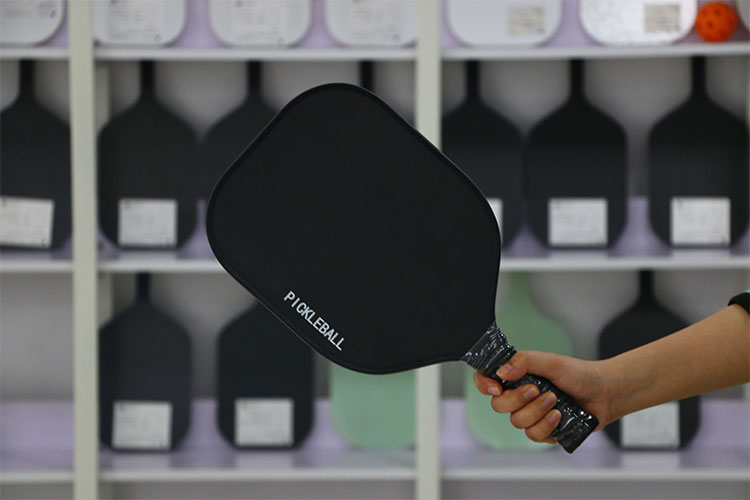Pickleball Paddle Materials and Development
Pickleball is growing rapidly in popularity and with it the demand for equipment. The choice of material for a pickleball paddle is a key factor in its performance and player experience. This article provides an in-depth analysis of the main materials used in pickleball paddles, discussing the advantages and disadvantages of each type of material and its application in pickleball paddles, to help players and industry professionals better understand and select pickleball paddle materials.
What Are Pickleball Paddles Made Of?
Wood Material
Features and Benefits
Wooden material was the main material of early pickleball rackets and has the following advantages:
- Low Cost: The wood is easy to obtain, the processing technology is simple, and the manufacturing cost is low.
- Natural Texture: Wooden rackets feel comfortable in the hand and are suitable for beginners.
Disadvantages and Limitations
Although wood-based materials have their advantages, they also have obvious disadvantages:
- Heavier Weight: Compared with modern materials, wooden rackets are heavier and are not conducive to fast swings.
- Poor Durability: Wooden rackets are easily affected by the environment and are prone to damage and deformation.
Application Scenario
Wooden rackets are suitable for beginners and casual players, especially on a limited budget.
Composite Materials

Features and Benefits
Composite materials are widely used in pickleball racquets and include the following main categories:
- Fiberglass Composite: Good toughness and moderate weight, providing balanced performance.
- Carbon Fiber Composite: Light weight and high strength, providing superior performance and control.
Disadvantages and Limitations
Despite the excellent performance of composites, there are some challenges:
- Higher Cost: The manufacturing process of composite materials is complex and the cost is higher.
- High Processing requirements: professional manufacturing equipment and processes are required.
Application Scenarios
Composite rackets are suitable for intermediate and advanced players, especially tournament players who require greater performance and control.
Carbon Fiber Material
Features and Benefits
Carbon fiber is the material of choice for high-end pickleball paddles, with the following characteristics:
- Extremely Lightweight: Carbon fiber paddles are extremely lightweight and easy to swing quickly.
- Extremely Strong: Extremely high tensile strength and rigidity for superior shot control and power.
Disadvantages and Limitations
Carbon fiber materials also have their shortcomings:
- Expensive: Carbon fiber raw materials and processing costs are high, making it more expensive.
- Fragility: Despite its high strength, carbon fiber can be more brittle in some situations.
Application Scenarios
Carbon fiber pickleball paddles are suitable for professional players and high-level competitions, especially players who have extremely high requirements for paddle performance.
Fiberglass Material
Features and Benefits
Fiberglass material is a cost-effective choice with the following advantages:
- Moderate Weight: Lighter than wood and heavier than carbon fiber, suitable for most players.
- Good Durability: Good impact resistance and durability.
Disadvantages and Limitations
The main disadvantages of fiberglass materials include:
- Less Elastic: Compared with carbon fiber, glass fiber has slightly less elasticity and performance.
- Complex Processing: Although not as good as carbon fiber, it still requires professional processing equipment.
Fiberglass pickleball paddle are suitable for amateur players and intermediate players who want to improve their level, providing good performance and balanced cost performance.
Future Development Trends
With the advancement of technology and changes in market demand, the development of pickleball paddle materials shows the following trends:
1. Sustainable Materials:
- Eco-friendly Materials: Use renewable and recyclable materials to reduce environmental impact.
- Bio-based Materials: Development and application of bio-material-based paddles.
2. Smart Materials:
- Sensing technology: Integrate sensors and smart materials to improve the interactivity and data analysis capabilities of the paddle.
- Adaptive materials: Develop materials that can self-adjust according to environmental changes to improve the performance of the paddle.
3. Composite Technology:
- Multi-layer composite: Combining multiple materials to optimize the overall performance of the paddle.
- Nanotechnology: Applying nanomaterials and technologies to improve the strength and performance of the paddle.
By understanding the characteristics and applications of various materials, players and manufacturers can better select and develop paddles that meet different needs. In the future, with the continuous advancement of technology, pickleball paddle materials will become more diverse and high-performance, bringing more innovation and development opportunities to the sport of pickleball.




